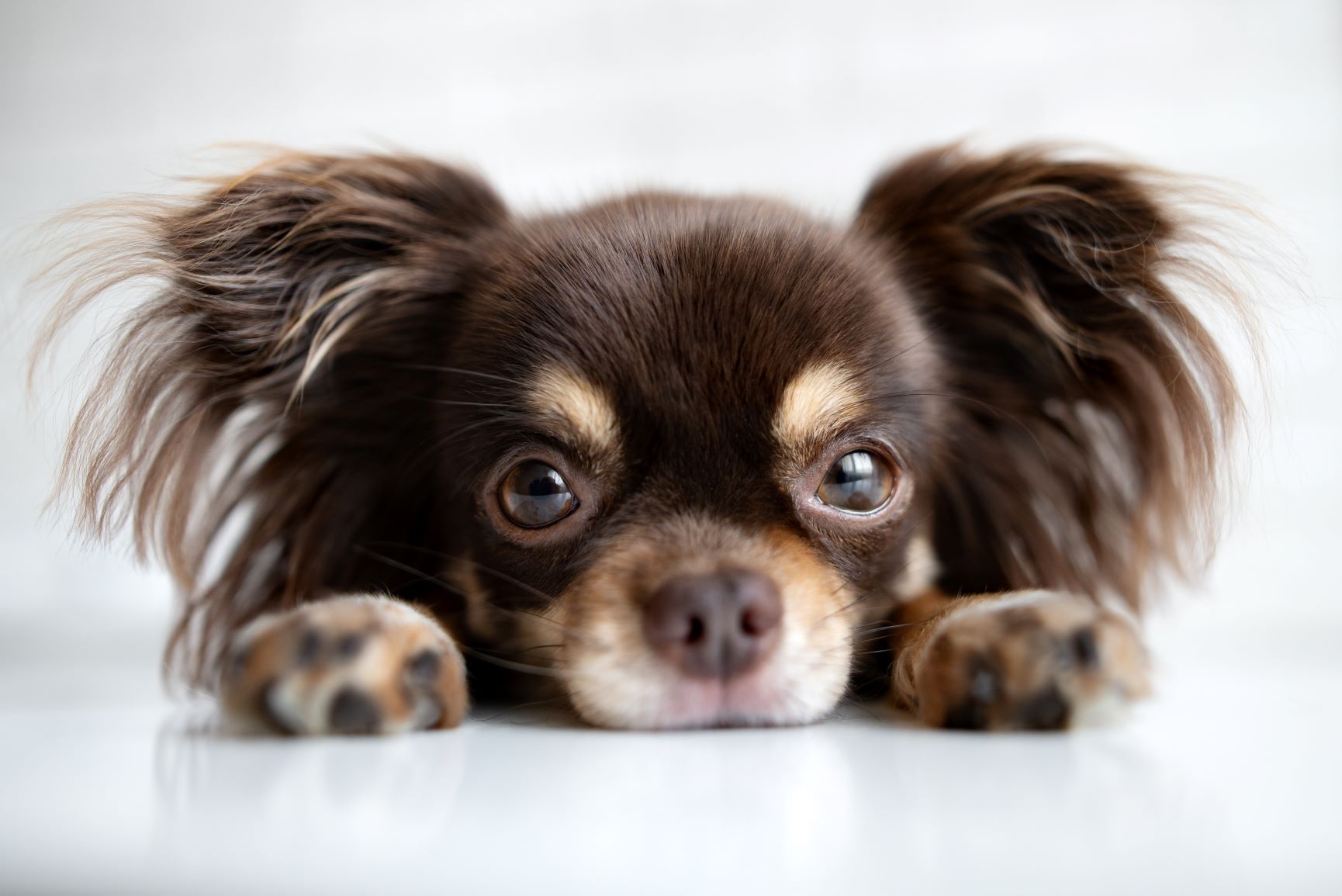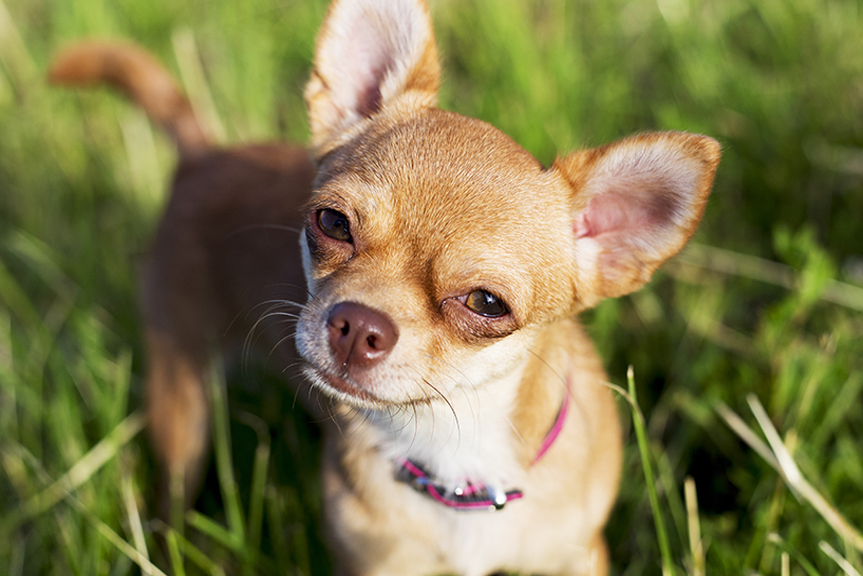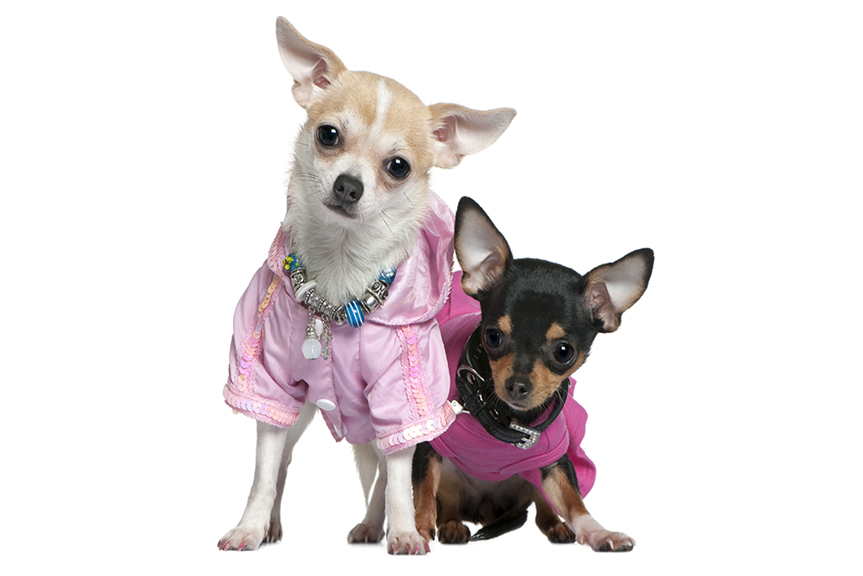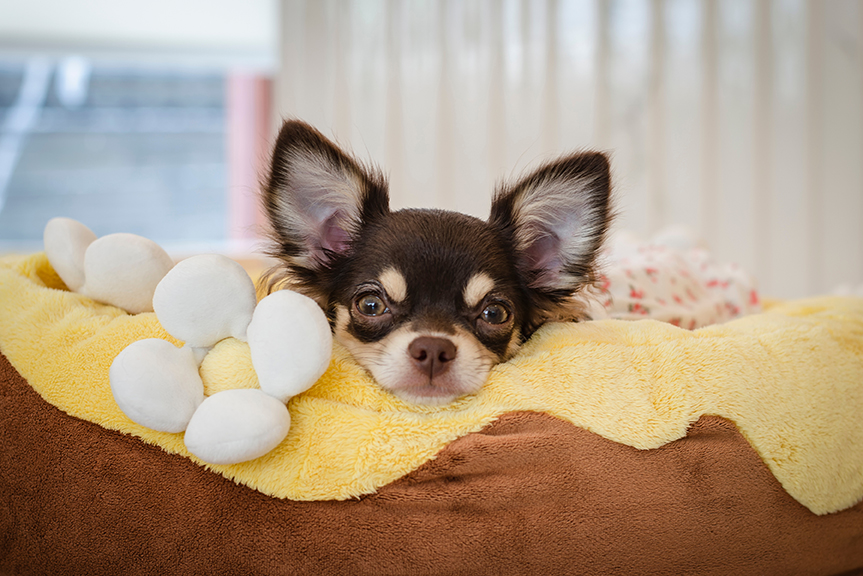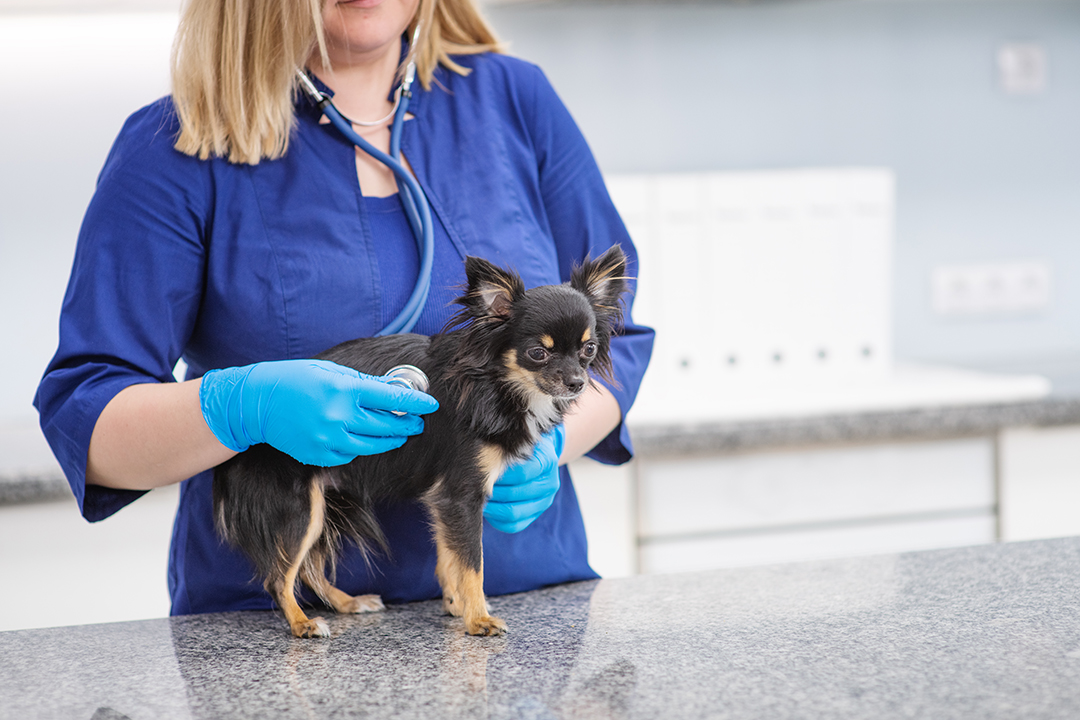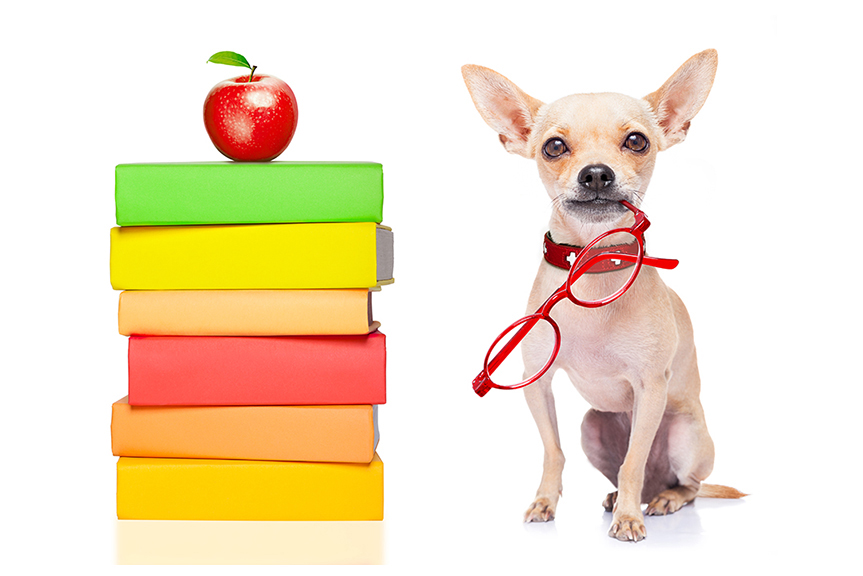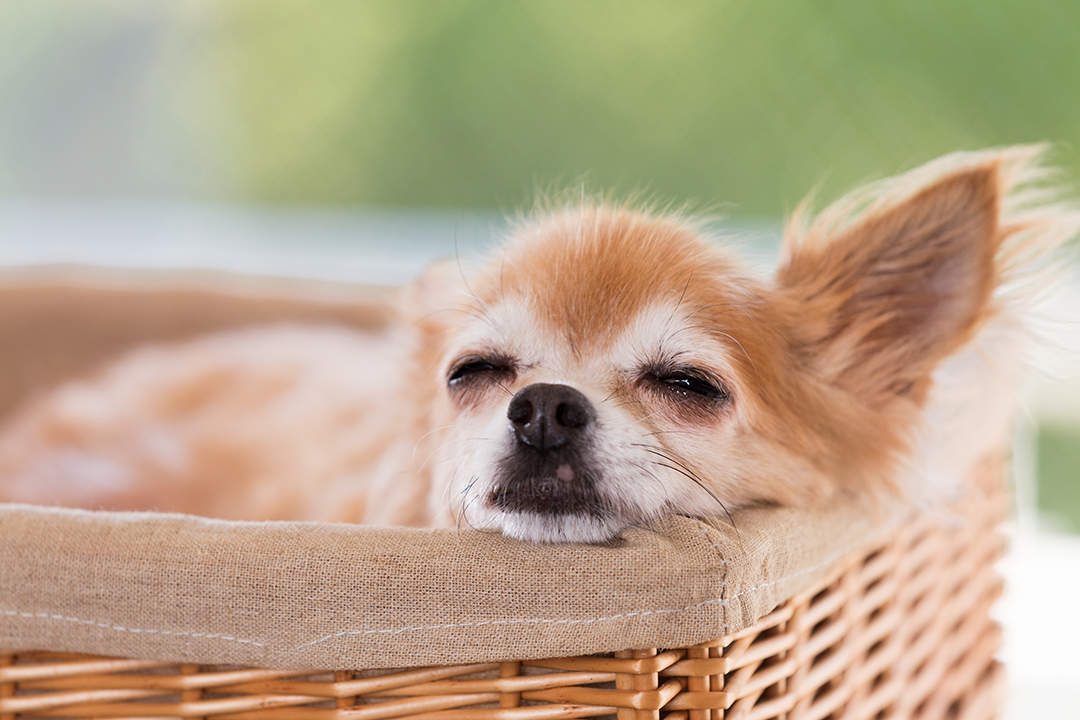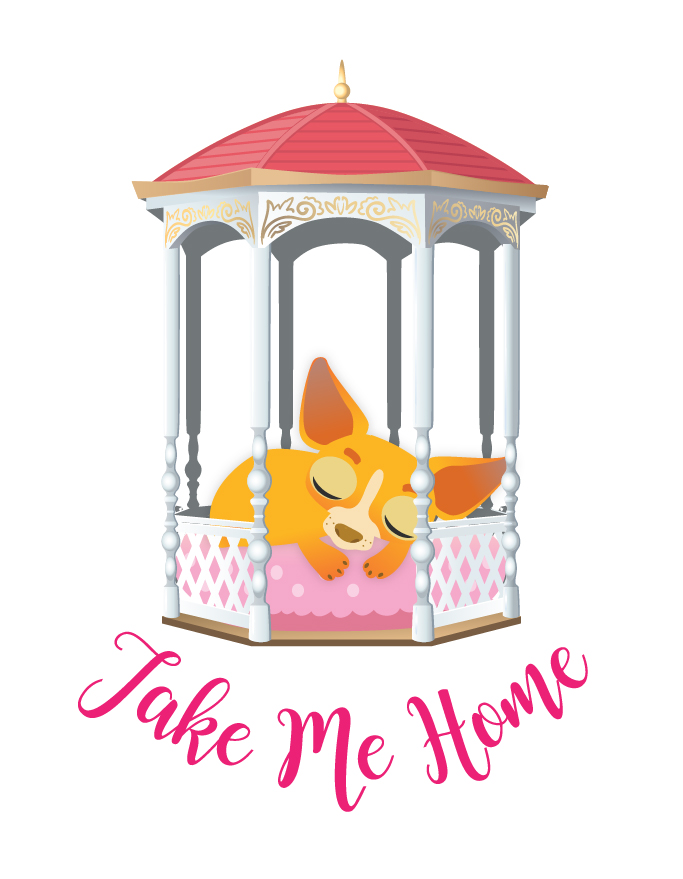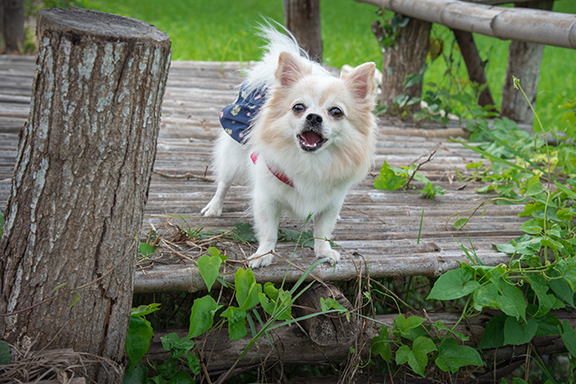Chihuahua Breed Overview
Breed Origin
The history of the Chihuahua is steeped in speculation. The most popular tale is Chihuahua ancestors date back to the ninth century in Mexico during the Toltec civilization. The Toltecs lived alongside a small, long haired dog called a Techichi. The Toltecs brought Chihuahuas into their homes as pets and also used them in religious ceremonies to make atonement for sins and guides for the spirits of the dead. Later, Chihuahuas were a major part of the Aztecs life in the eleventh century. The Aztecs civilization owned a Chihuahua until their death, where the dogs were usually sacrificed to guide and protect their person in the afterlife. Both the Toltecs and the Aztecs considered the Techichi to be a sacred dog and companion. Chihuahuas were also thought to protect against evil spirits.
In 1850, the Chihuahua, both long and short hair, was discovered in the state of Chihuahua. What really brought awareness to the Chihuahua, was when a popular Italian opera singer, Madame Adelina Patti was given a Chihuahua as a gift along with flowers from the Mexican president in 1890. Her Chihuahua accompanied her as she traveled the world on her tours which brought huge popularity to the Chihuahua breed. Chihuahuas as we know them today were rare until the early 20th century, when the first Chihuahua was registered with The American Kennel Club in 1904. The Chihuahua Club of America, founded in 1923, was created to develop a community of Chihuahua breeders and better establish the breed in the United States.
Later in the 1930’s and 1940’s Xavier Cugat, a musician originally from Spain appeared on television and movies with his Chihuahuas, which brought massive popularity to the breed and in 1964 they were the third most popular breed in the United States. The American Kennel Club (AKC) now registers thousands of Chihuahuas annually.
If you have yet to experience the wonderful charm of a Chihuahua, you are in for a real treat. This breed will steal your heart; they are adorable, cute and small, but will entice you with their big personality as well as their loveable and devoted demeanor. They are also very protective of their person and wary of strangers, so socialization is especially important in this breed.
Every day is a new experience with your Chihuahua, as their many cute expressions and high-spirited personality are constantly evolving. Although Chihuahua lovers come from all walks of life, they are totally committed to their dogs, ensuring that they have the best quality care they can provide. Although pretty much anyone across the world can recognize the main characteristics of the Chihuahua, they are the least understood dog breed. For this reason, the purpose of this website is to offer the best overview of Chihuahuas, as well as more advanced information including tips and tricks, so you and your Chi have a wonderful life together.
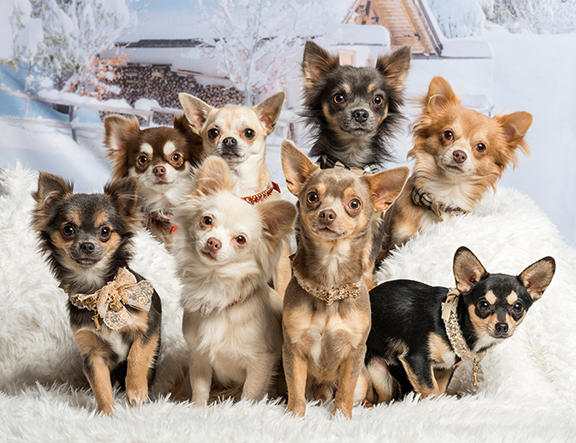
Chihuahua Physical Characteristics
Chihuahuas are a small graceful dog with full, luminous and very expressive eyes, large, wide pointy ears and apple heads that may or may not have a molera. What is a molera you ask? A molera is an opening in the top of a dog's skull that most Chihuahuas are born with. This happens when the parietal and frontal bones have not fused together. Normally, a puppy’s skull will gradually fuse together over time. This process may take anywhere from three months to three years to fully close, but there is a possibility that it may never close. If a Chihuahua's molera does not fully close, it will likely shrink as cartilage pushes the parietal and frontal skeletal plates together.
You may have heard Chihuahuas referred to as apple head or dear head. The main difference refers to their muzzle and facial structure. Apple head Chihuahuas, the breed standard, have a round apple-like head with a 90-degree angle where the muzzle joins the forehead along with shorter jaw lines, necks and legs, while Deer head Chihuahuas have a longer deer-like head with a sloped junction of approximately 45 degrees where the muzzle joins the forehead and have longer muzzles, necks and legs. Deer head Chihuahuas can be registered with the AKC if they are purebred, however they cannot compete in dog shows as they the deviate from the official Chihuahua characteristics. There are other differences between the two, but you can usually tell a Chihuahua's type by looking for these specific characteristics. Chihuahuas can be born with, or later develop, characteristics of both apple head and deer head Chihuahuas. A Chihuahua with a perfectly found apple-shaped dome may feature the longer muzzle and larger ears of a deer head variety and vice versa.
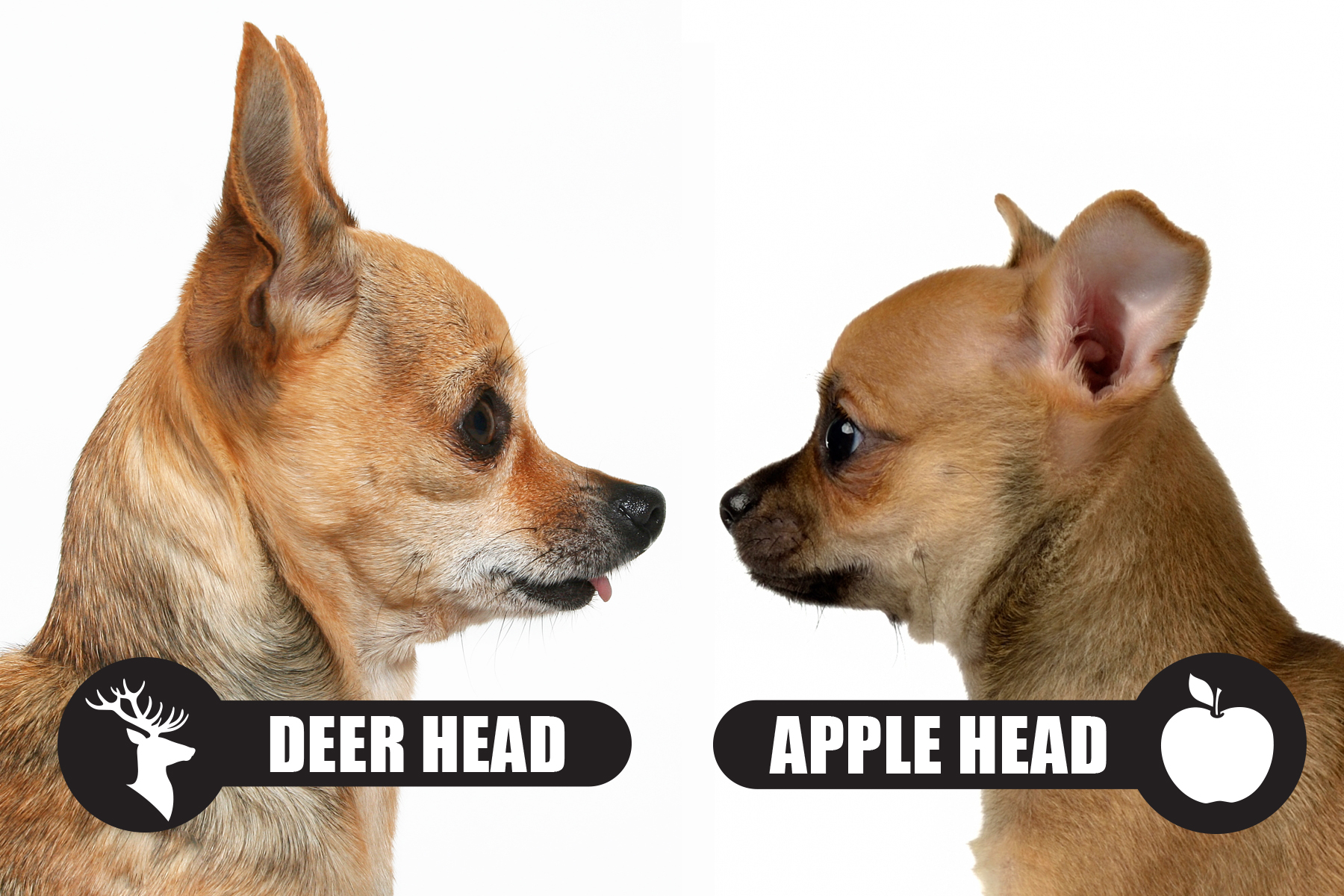
A Chihuahua’s small size is an advantage and makes it very convenient for Chihuahua owners, since not much space is needed, you will experience low food bills, grooming is easy, and exercise only requires short daily walks. The Chihuahua’s height and weight can vary depending on bone structure. The AKC standard height is five to eight inches with a healthy weight not exceeding six pounds. They come in either a smooth and short haired coat or a long-haired coat in a large variety of colors. Surprisingly, the long-haired coat sheds less than the smooth short-haired coat. The two varieties are identical except for their coat. Popular colors are Black, Blue, Brindle, Chocolate, Creme, Fawn, Gold, Merle, Red and White, along with multiple variations and markings. My favorite is chocolate with white markings. Of these the rarest coat colors and markings are Blue, Brindle, Merle and Pure White. Another unique color is Silver, which are a shade of gray with white hairs dispersed throughout for a shiny gray outcome.
Chihuahua coat colors are determined by the interaction of several genes. Here is the technical description of how the large variety of Chihuahua's coats are created which is never a sure thing. When a locus, which is the specific location of a gene has has several alternative alleles (alternative forms of a gene that are formed by a mutation and found at the same spot on a chromosome), a dominant hierarchy will exist. An example of dominant hierarchy with several different alleles at one locus is when you see white spotting on a Chihuahua's coat. Alleles for more white are always more recessive to those for less white. See details below on the various colors and descriptions. Whatever color you are looking for, you are bound to find it in the wide variety of coat colors in an adorable Chihuahua.
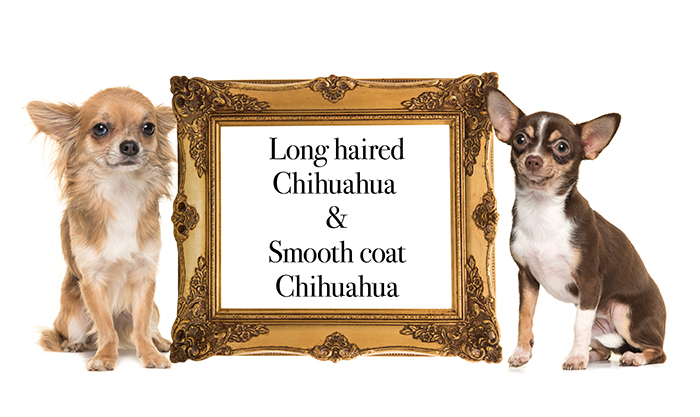
Chihuahua Colors and Descriptions
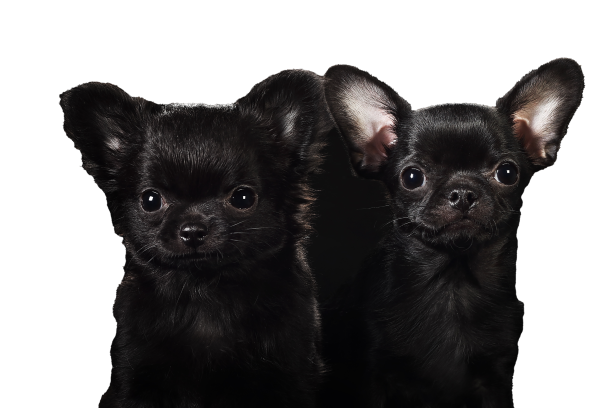
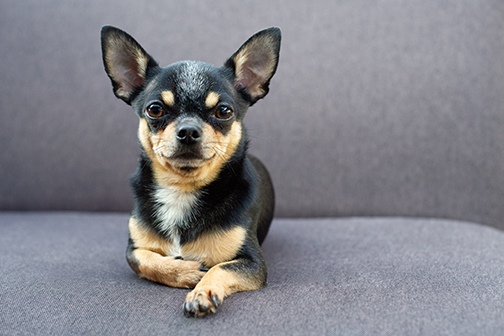
Black Coat: A full, solid black is exceedingly rare. Many black Chihuahua dogs will have some type of marking on the body. Black and Tan is also a popular color with tan on the chest, legs and eyebrows.
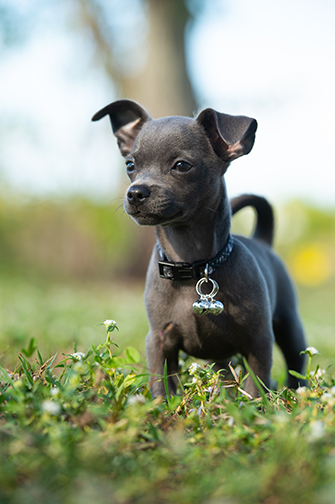
Blue Coat: This coat color is also very rare. Both parents must carry the recessive blue gene. Blue is determined by skin color. The coat may appear to be lighter shade of black. It is the skin pigmentation that classifies a Chihuahua as blue; the paw pads, lips, eye rims and nose will be blue. For many Chihuahuas, these areas may appear black, but outdoors in the sunlight is where you can really tell the difference of a noticeable bluish tint. The Blue & Tan variety is blue, as described above, with tan points, usually with tan tips on the paws. Some may have tan around the ears and/or above the eyes as eyebrows.
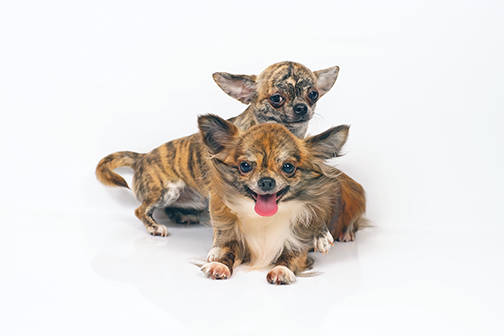
Brindle Coat: This pattern appears as a striping. Most brindle Chihuahuas are black over fawn with an orange hue. This coat marking looks like tiger stripes which can be thin or thick.
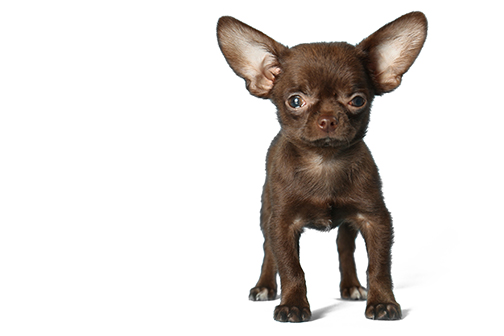

Chocolate Coat: Chocolate Chihuahuas have brown fur. A true chocolate colored Chihuahua will have brown eye rims, nose, lips, and paw pads. You will also see Chocolate coats with white or tan markings around the face, chest and legs and some with kiss marks above their eyes.
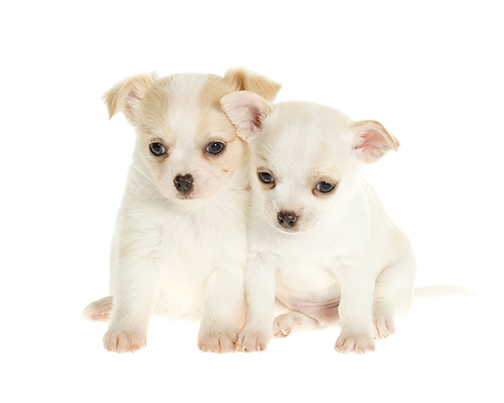
Creme Coat: Creme Chihuahuas are a light tan which reflects an almost white color.

Fawn Coat: This is a light tan that may have an undertone of red. This is the typical Chihuahua coat color that comes to mind for most people.

Gold Coat: Shinier than fawn and a honey color that is especially noticeable when the Chihuahua is outside.
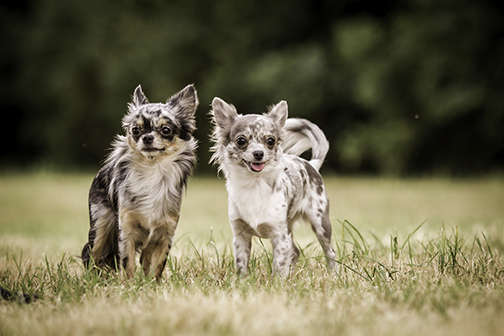
Merle Coat: This is an irregular splashed pattern, with darker blue or black patches over a lighter shade of the same color. This pattern can vary so much that sometimes you have to look very closely to see slight areas of merle. This color may carry through to the eyes as well. The pattern is caused by one copy of the dominant gene M, where one parent must be merle to produce a merle puppy. It is important to never breed two Merles together as this combination can produce two copies of the dominant M gene which has a high risk of causing sight and hearing problems in Chihuahuas. Another important fact is that dogs with large areas of white in their coat, can be a hidden merle usually occurring in coat colors of creme, red, sable or brindle. For this reason it is not recommended to breed two merles, as well as a merle with a creme, red, sable or brindle dog.

Red Coat: This color can vary. This can range from a dark orange, brown/orange, slightly darker than creme to a dark red color.

White Coat: This color is the rarest color of Chihuahua. Think of snow white color. A truly white Chihuahua must be bred with two pure white Chihuahuas. The best way to know if you have a white versus a creme Chihuahua, is to look at the eyes and skin. A pure white Chihuahua has lighter eyes, pale nose, eye rims and paw pads in shades of pink or beige.
Chihuahua Personality
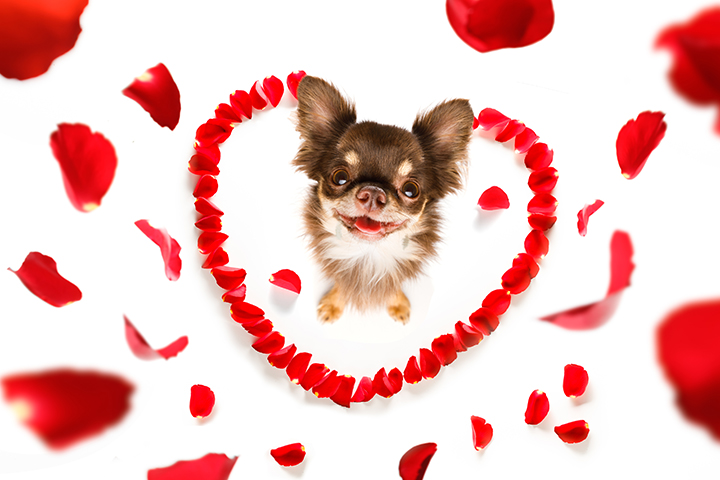
A Chihuahua’s personality traits include confidence fearlessness and a devoted demeanor. Chihuahua’s are usually described as having a huge personality and attitude packed into an adorable, compact body. Here are the top ten traits that every Chihuahua lover already knows.
1. Chihuahuas are enormously loyal and loving and want nothing more than to be with you everywhere. Their tiny size makes them extremely portable. Mine would follow me from room to room or would place herself in the perfect spot, so she could see me move from multiple rooms.
2. They tend to be mistrustful of strangers, which may make them the world’s tiniest watchdogs.
3. Chihuahuas are extremely intelligent and learn quickly, especially when you can make training fun including having plenty of treats handy. They can successfully compete in dog shows.
4. These tiny adorable dogs have giant personalities and will rule the house if you let them. Although, it can be difficult to be firm with a Chihuahua because they are so charming and entertaining, you must stay strong and consistent especially during the initial training period. They must be taught the ground rules, or your Chi will be ruling the house.
5. They are named after for the Mexican state of Chihuahua, where the breed originated. The modern Chihuahua is most likely a cross between the Techichi, an ancient breed from Central and South America, and a small hairless dog.
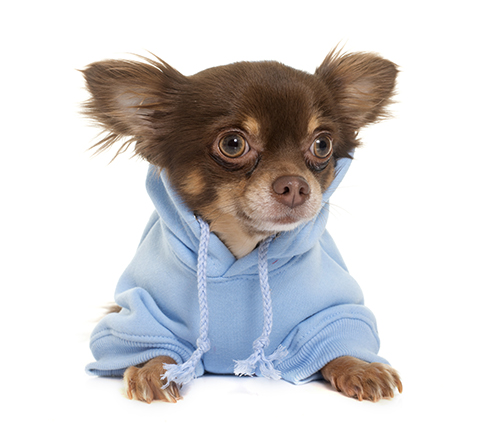
6. Because they were bred for the warm temperatures of Mexico, Chihuahuas do not like the cold. This is where all the cute attire comes in. At home, Chihuahuas seek out the warm spots, even if that means burrowing under the blankets in bed with you at night.
7. Because Chihuahuas are so small and delicate, they might not be the best choice for families with young children. If you do have kids, you will have to teach them to be gentle and kind to the dog. Being especially careful when closing doors or running through the house is important to keep in mind.
8. Americans tend to pronounce the breed name as “Chuh-wow-wowa,” the true pronunciation is more like “Shee-wa-wa.”
9. At the end of the day, the Chihuahua wants to love and be loved, and they desire this with such ferocity. While the Chihuahua is small and adaptable, they are one of the neediest dog breeds in existence. So, if you do not have or want to spend the necessary time for this incredible dog, it is probably not the breed for you.
10. And finally, Chihuahua lovers are famously devoted to this graceful and sassy breed. They are popular with celebrities, too. Marilyn Monroe had one named Choo-Choo; Jamie Lee Curtis not only acted with Chihuahuas in Beverly Hills Chihuahua, but also has one in real life; Enrico Caruso, a pop- opera star had a pack of Chihuahuas, Paula Abdul, Paris Hilton of course, Jane Mansfield and the list goes on.
Chihuahua Temperament
Chihuahuas are loving, loyal, intelligent, excitable, and sociable towards loved ones, all of which makes for a great companion. They are happy dogs while at home, but do not trust strangers. One of my first my first experiences with my Chi, was when I was holding her and a friend visiting started to pet her and my Chi clearly did not want to be touched by her at that moment. When I placed her on the ground, she was fine. This was clearly an example of her being overprotective of me. It is especially important that you socialize young Chihuahuas, so they learn to accept friends, family and other visitors graciously. If you young Chihuahua liberally uses their high-pitched bark, be sure not to reward that that behavior, so it will taper off.
Chihuahuas tend to be a one person dog and are extremely devoted. They still love other family members, but are especially devoted to one person in the family. They form a lifelong commitment to their family and are protective and dependent on them. Sadly, some people do not share that same commitment. When Chihuahuas are uprooted from their family it can be extremely devastating for them. Please do not get a Chihuahua unless you plan to have them for life, including in their senior years when they will need extra tender loving care.
They also can be clannish and stick close to other Chihuahuas and not so much to other breeds. They have no issue standing up to large breeds that could eat them for lunch. They are bold, quick witted and saucy. One of the most contagious characteristics of a Chihuahua is their enthusiasm for life. They run around the house with excitement, all while always remaining alert to everything around them.
Lastly, Chihuahuas contagious enthusiasm, lust to love, and excitability are exactly what make these dogs loved by their owners.
Health and Longevity of Chihuahuas

Chihuahuas enjoy a long life of 14 to 16 years on average, although some have lived to 20 years. They are the longest-lived dog breed and usually have a healthy life overall. However, Chihuahuas do have their share of hereditary disorders, as all breeds do. They are prone to patellar luxation, a painful condition, where their kneecap slips in and out of position, overweight and older Chihuahuas are prone to a collapsed trachea and hypoglycemia can be a major issue in some puppies and some small adults.
More on these hereditary issues in the wellness section. Additionally, tiny Chihuahuas, known to some as teacup, although not an official variety, have some physiological issues including organ size difficulties within their small frame, large eye size and other small issues may occur. Overall, your Chihuahua will make an excellent companion, loving best friend and has a great chance to have an extremely healthy life.
Chihuahua Breed Standards
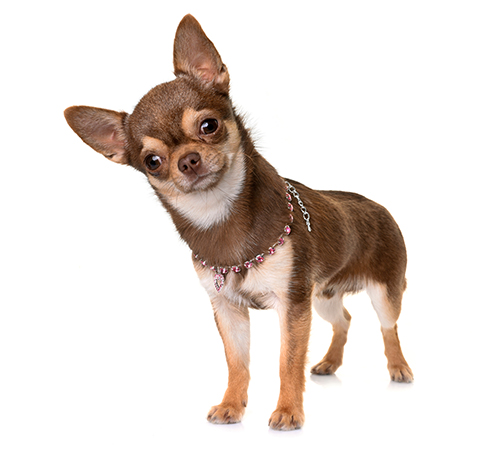
The American Kennel Club (AKC) describes Chihuahuas as a graceful, alert, swift-moving compact little dog with saucy expression, and with terrier-like qualities of temperament. For purposes of competition, the AKC's official Chihuahua breed standards of size, proportion, substance, neck and body including disqualifications are listed below. These breed standards are a breeders blueprint and are used by dog show judges to determine how closely each dog conforms to their breed standard. Dogs that are disqualified by breed standard can still compete in AKC companion events and certain AKC performance events.
Size, Proportion, Substance
Weight: A well balanced little dog not to exceed 6 pounds.
Proportion: The body is off-square; hence, slightly longer when measured from point of shoulder to point of buttocks than height at the withers. Somewhat shorter bodies are preferred in males. Disqualification: Any dog over 6 pounds in weight.
Head: A well rounded "apple dome" skull, with or without molera.
Expression: Saucy.
Eyes: Full, round, but not protruding, balanced, set well apart-luminous dark or luminous ruby. Light eyes in blond or white-colored dogs permissible. Blue eyes or a difference in the color of the iris in the two eyes, or two different colors within one iris should be considered a serious fault.
Ears: Large, erect type ears, held more upright when alert, but flaring to the sides at a 45 degree angle when in repose, giving breadth between the ears. Stop - Well defined. When viewed in profile, it forms a near 90-degree angle where muzzle joins skull.
Muzzle: Moderately short, slightly pointed. Cheeks and jaws lean.
Nose: Self-colored in blond types, or black. In moles, blues, and chocolates, they are self-colored. In blond types, pink noses permissible.
Bite: Level or scissors. Overshot or undershot, or any distortion of the bite or jaw, should be penalized as a serious fault. A missing tooth or two is permissible. Disqualifications: Broken down or cropped ears.
Neck, Top-line, Body
Neck: Slightly arched, gracefully sloping into lean shoulders.
Topline: Level.
Body: Ribs rounded and well sprung (but not too much "barrel-shaped").
Tail: Moderately long, carried sickle either up or out, or in a loop over the back with tip just touching the back. (Never tucked between legs.) Disqualifications - Docked tail, bobtail.
Forequarters: Shoulders - Lean, sloping into a slightly broadening support above straight forelegs that set well under, giving free movement at the elbows. Shoulders should be well up, giving balance and soundness, sloping into a level back (never down or low). This gives a well developed chest and strength of forequarters. Feet - A small, dainty foot with toes well split up but not spread, pads cushioned. (Neither the hare nor the cat foot.) Dewclaws may be removed. Pasterns - Strong.
Hindquarters: Muscular, with hocks well apart, neither out nor in, well let down, firm and sturdy. Angulation - Should equal that of forequarters. The feet are as in front. Dewclaws may be removed.
Coat: In the Smooth Coats, the coat should be of soft texture, close and glossy. (Heavier coats with undercoats permissible.) Coat placed well over body with ruff on neck preferred, and more scanty on head and ears. Hair on tail preferred furry. In Long Coats, the coat should be of a soft texture, either flat or slightly wavy, with undercoat preferred. Ears - Fringed. Tail - Full and long (as a plume). Feathering on feet and legs, pants on hind legs and large ruff on the neck desired and preferred. (The Chihuahua should be groomed only to create a neat appearance.) Disqualification: In Long Coats, too thin coat that resembles bareness.
Color: Any color - Solid, marked or splashed.
Gait: The Chihuahua should move swiftly with a firm, sturdy action, with good reach in front equal to the drive from the rear. From the rear, the hocks remain parallel to each other, and the foot fall of the rear legs follows directly behind that of the forelegs. The legs, both front and rear, will tend to converge slightly toward a central line of gravity as speed increases. The side view shows good, strong drive in the rear and plenty of reach in the front, with head carried high. The top-line should remain firm and the back-line level as the dog moves.
Temperament: Alert, projecting the 'terrier-like' attitudes of self-importance, confidence, self-reliance. Disqualifications: Any dog over 6 pounds in weight. Broken down or cropped ears. Docked tail, bobtail. In Long Coats, too thin coat that resembles bareness.
Courtesy of American Kennel Club
25 Interesting Chihuahua Facts
Chihuahua Dog Care
Quick Links for the main topics you will find on Love Your Chihuahua
